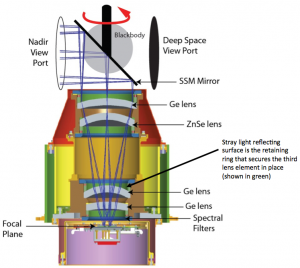About the Thermal Infrared Sensor (TIRS) Scene Select Mirror (SSM) encoder current anomaly
On November 1, 2015, the Thermal Infrared Sensor experienced an anomalous condition related to the instrument’s ability to accurately measure the location of the Scene Select Mirror (SSM). While all TIRS data continue to be collected since this date, they are processed and made available as “zero-fill” (black/no data), until processing parameters and algorithm changes are made to allow reprocessing of nominal Level-1 products containing valid TIRS data.
An alternative operations concept for determining the exact position of the SSM through analysis of instrument telemetry data provides information to regularly update the line of sight (LOS) model that is used for geometric correction and alignment of TIRS and OLI data. All collected TIRS data will become available in Level-1 products once the LOS model parameters are finalized, and the geometric processing algorithms and code in the Landsat Level-1 Product Generation System (LPGS) have been updated, tested, and verified.
As of February 12, 2016, many* of the Landsat 8 scenes acquired from October to December 2015 have been reprocessed into nominal Level-1 products containing valid TIRS data and are available for download, and can also be submitted for higher-level Surface Reflectance data processing via the ESPA On-demand interface.
*A number of scenes acquired from approximately 10 pm CT on November 1, 2015 to approximately 5 pm CT on November 2, 2015 will still contain zero-fill TIRS data . These scenes will not be reprocessed until April 2016.
Landsat 8 scenes acquired from January to March 2016 will be reprocessed and made available starting in April 2016.
Additional Information about TIRS SSM can be found on the Landsat Missions website.
Thermal Infrared Sensor (TIRS) Stray Light Investigation
 Shortly after the launch of Landsat 8, the Landsat calibration team noticed that thermal energy from outside the normal field of view (stray light) was affecting the data collected by the satellite’s Thermal Infrared Sensor (TIRS). Ground-based measurements indicate a significant error in the radiance measured by the sensor, and investigations showed that stray light increases the reported temperature by up to 4 Kelvin (K) in band 10 and up to 8 K in band 11.
Shortly after the launch of Landsat 8, the Landsat calibration team noticed that thermal energy from outside the normal field of view (stray light) was affecting the data collected by the satellite’s Thermal Infrared Sensor (TIRS). Ground-based measurements indicate a significant error in the radiance measured by the sensor, and investigations showed that stray light increases the reported temperature by up to 4 Kelvin (K) in band 10 and up to 8 K in band 11.
The errors vary throughout the scene and depend upon radiance outside the instrument field of view, which is not inherently correctable in the Landsat Level 1 processing.
An algorithm to correct the stray light is showing promise to reduce the errors. The amount of stray light in the scenes is estimated using scenes acquired before and after the target scene, as well as the edge pixels of the target scene. The stray light estimate is then subtracted from the target scene.
Even after this correction, the results will not be considered precise enough to use a split-window algorithm for surface temperature retrieval. More information will be provided as results from further analyses become available.
Additional Information about TIRS Stray Light can be found on the Landsat Missions website.






